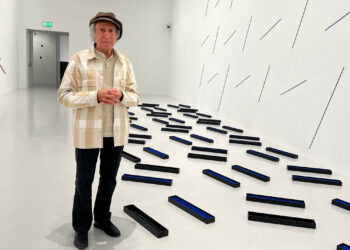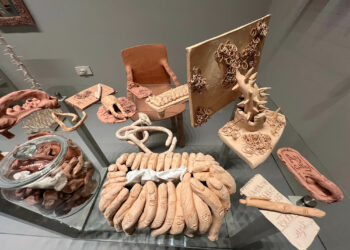Some artists complicate the creative process in the telling, but Callan Grecia insists that his is simple. Scrolling, reading and viewing are the primary inputs that fuel his imagination. He cannot approach the canvas without prior immersion in the media from which he derives his vignettes.
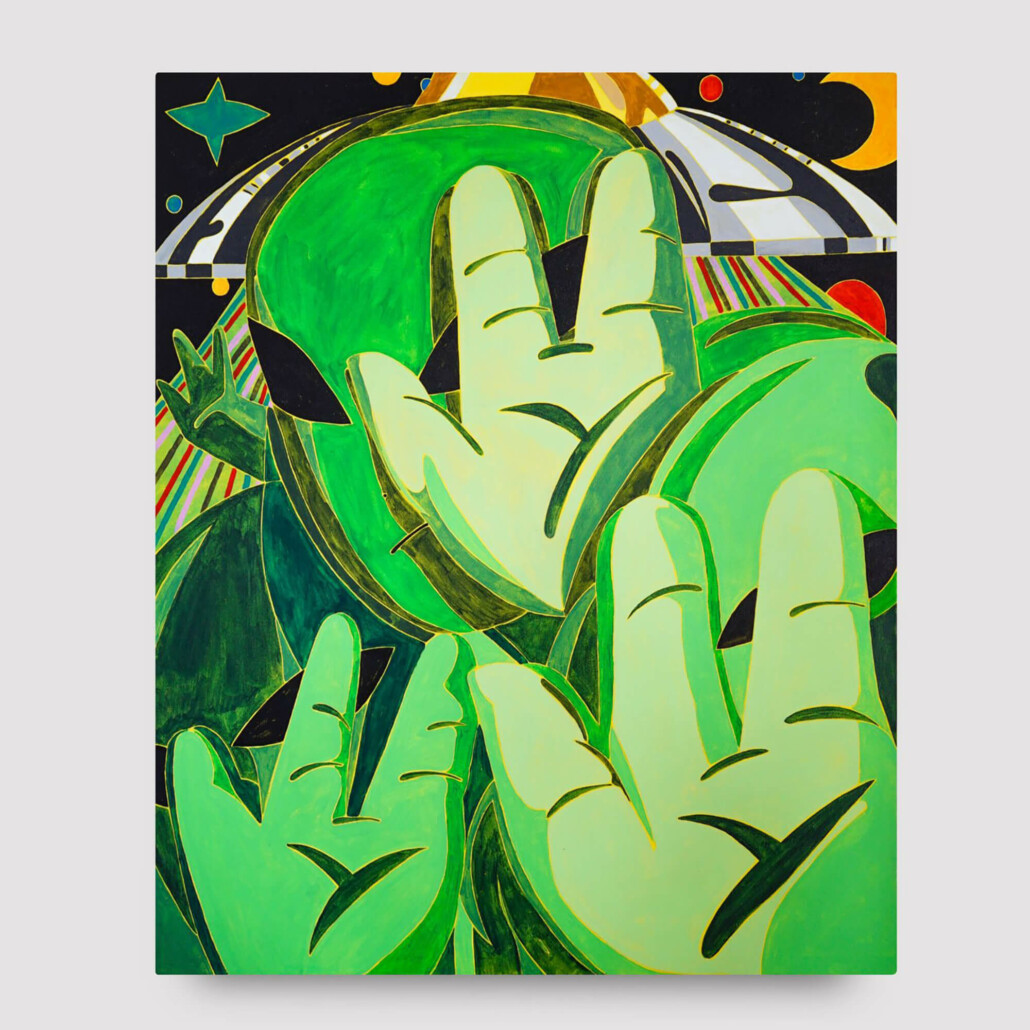
We Don’t Come In Peace, We Just Hate Photos, 2022. Acrylic on canvas, 120 x 100cm. © Callan Grecia
Grecia regards himself as a draughtsman first and a painter second, so he starts with a Lyra 6B pencil and sketchbook, using three tones against the white of the paper to draw miniatures that are then shortlisted weekly. Only the strongest concepts – usually one in five – are expanded and colourised on the canvas.
Colour adds dimensionality, but Grecia is at pains to explain how he translates monochromatic pencil tones into the vivid, unadulterated hues of ‘Absolute Lightspeed’. “I’ve never thought of myself as a colourist or someone who is attuned to colour,” he admits. The process is mostly intuitive, but he knows his work is bright, and attributes this to an eye for contrast, trained in the tropical climate of Durban.
“If I were painting in a realist way perhaps I would mix colours, but I am so sure I am not a colourist that I don’t mix,” says Grecia with confidence in his choice of paint brand. The 50 non-standardised colours of Heritage Craft Acrylic Paints offer Grecia the palette and opacity he feels he needs to bring his best ideas to life.
Painting with acrylics was not easy for the self-described “bad-ass with oil paints”. “I sucked in the beginning,” due to the feel of the medium. Adjusting to the house-paint-like quality of acrylic necessitated a base coat on the canvas just so the artist’s brush would glide familiarly. This new consideration, along with others, forced changes in the way Grecia paints: a challenge the artist claims to enjoy in this relatively new, three-year journey with acrylics.
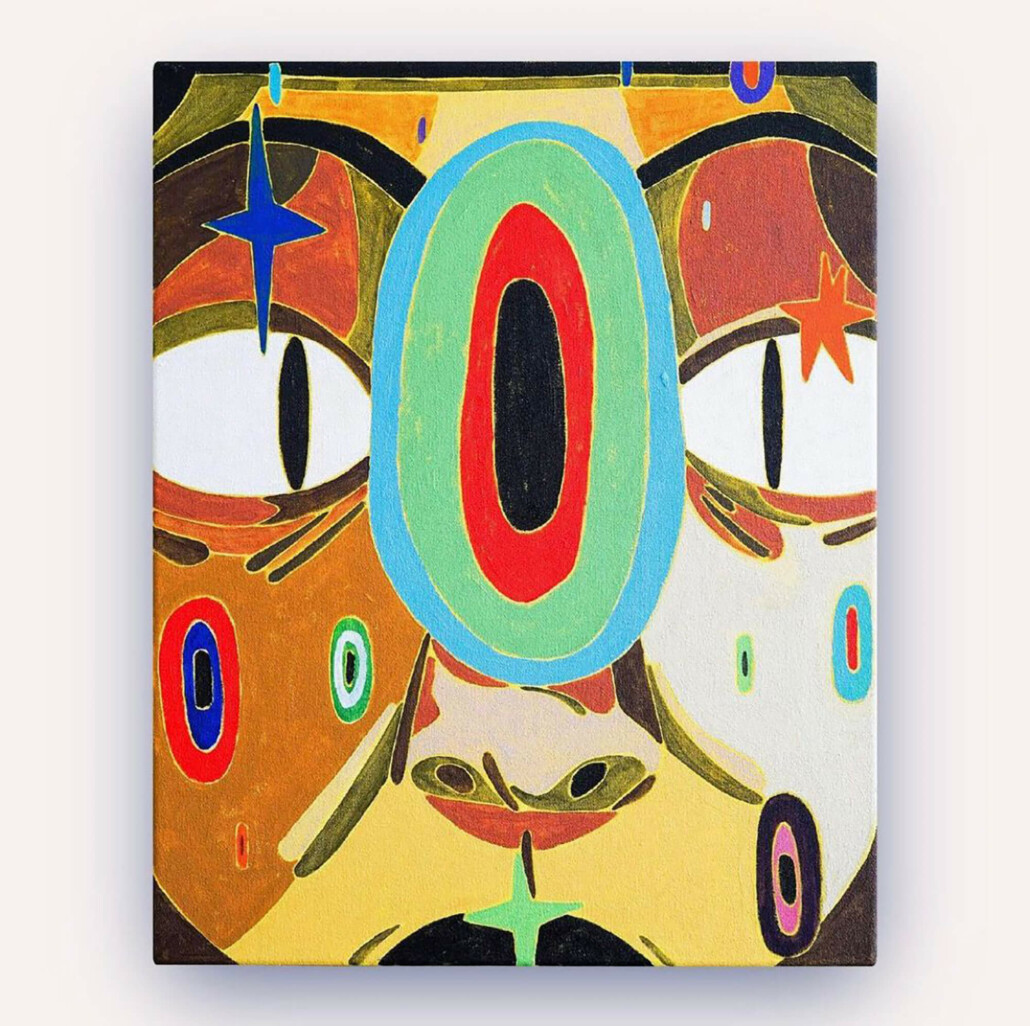
Floaters 1b, 2022. Acrylic on canvas, 50 x 40cm. © Callan Grecia
As a South African artist descended from the diasporic Indian community of Durban – the largest in the world outside of India – Grecia’s oeuvre has had to resist the imposition that it be a commentary on Indian positionality in a country obsessed with black-white relations. It is easy to read the alien motif ubiquitous in ‘Absolute Lightspeed’ as the marker of an outsider in racial terms, but it is simultaneously more and less than this interpretation. The alien iconography is representative of a personal aesthetics, influenced by the artist’s immersion in the popular imaginary of the 90s. Films like Independence Day (1996) and television programmes such as The Outer Limits (1995) centred extraterrestrials in the public consciousness, providing Grecia with an easily recognisable reference for feelings of isolation and rebellion.
The self-identifying “weird boy no one understands” conceals his true nature behind a mask and hints at this coping mechanism by depicting alien facades as disembodied, floating, two-dimensional headwear that could be applied to the face by a palm of the hand. Sometimes Grecia includes a green three-fingered salute to claim possession of a hidden self, ward off unwanted attention, or recognise those engaged in similar politics of the self.
“Painting is world-building,” proclaims Grecia, for a self in need of shelter and modes of representation. In an industry where taste-making is often the preserve of painters from wealthy families with artistic pedigree, the artist of colour at work on an autobiographical symbology must guard against an inferiority complex. Grecia bestows upon himself the permission to turn 90s pop-culture references such as the Nike swoosh or the E30 BMW 325is, into codes that not only edify but signify homage and aspiration.
In the Durban-based Indian community, the belief is that only those who have “made it” can afford face-brick homes. So the self-described “charo” in Grecia tips his hat to this marker of success by including brickwork in the background and edges of his frames. When the artist was growing up, his family was obsessed with the attainment of a particular type of vase that would communicate their taste and status to visitors. As a result, vases proliferate ‘Absolute Lightspeed’, signalling – tongue in cheek – the artist’s attainment of a certain prominence. The vases also hark back to a time when Grecia was cutting his teeth drawing still-lifes, thereby tracing the journey from relative anonymity to international solo exhibitions. As memento mori, the flower housing is a reminder to smell the roses before they are ultimately cast on the casket. Get the praise while it is due because eulogies are not for the departed.
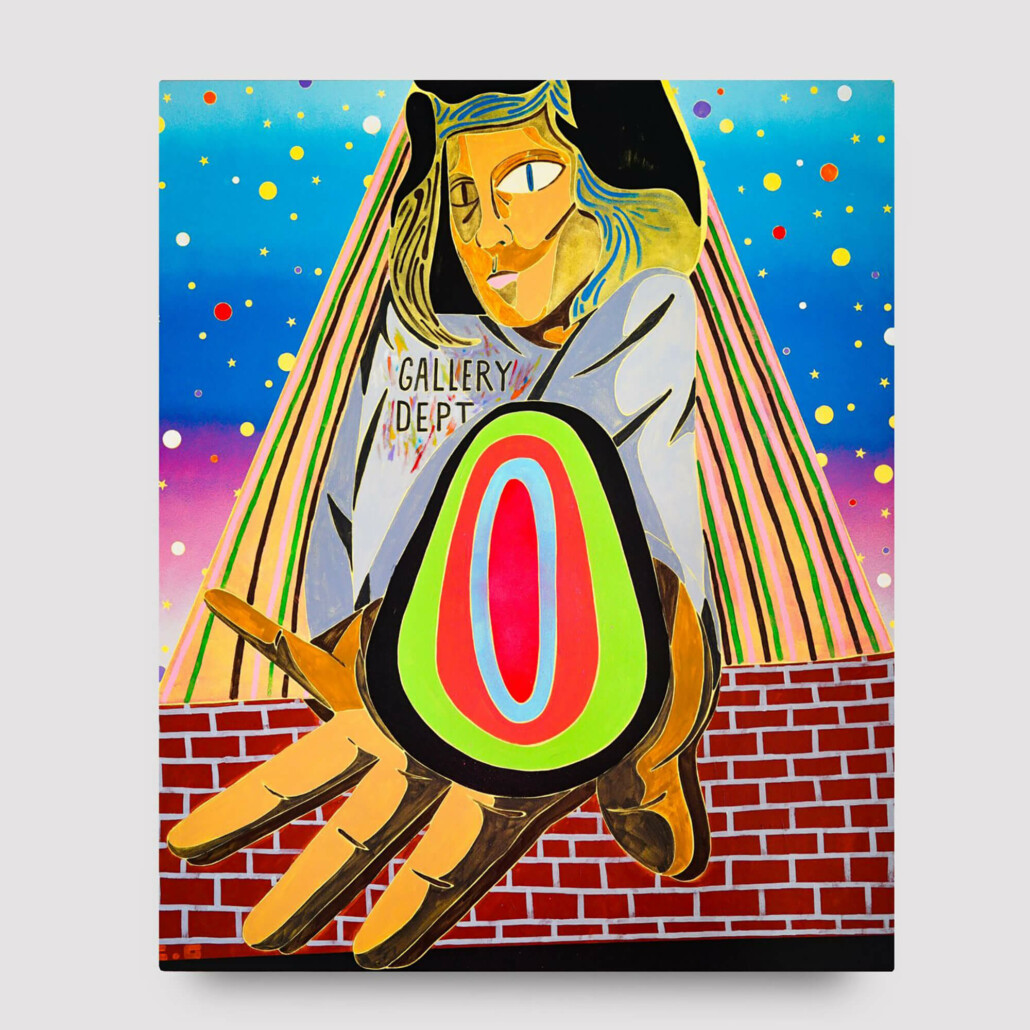
Eternal Return, 2022. Acrylic and spray paint on canvas, 120 x 100cm. © Callan Grecia
That being said, ‘Absolute Lightspeed’ is not overly concerned with mortality, though the temptation exists to impose a preoccupation with death on the portals propagating the series. Through them, Grecia doffs a cap to one of his favourite paintings: Peter Doig’s Tunnel Painting (Country-rock) of the year 2000. “I like the open-endedness,” Grecia explains of the exploration of divine pathways, teleportation, and the third-eye in ‘Absolute Lightspeed’. The humble smartphone, too, functions as a transportive device, though one leading not, necessarily, to the palace of wisdom. “I don’t have all the answers,” Grecia admits while searching for them in the writings of cultural theorist and aesthetic philosopher Paul Virilio.
“I only read him,” says Grecia of the urbanist whose final project involved building the first Museum of the Accident. Virilio believed that technology cannot exist without the potential for accidents. Technology – epitomised by television in his time – separates us from the events of real space and time. It causes us to lose sight of the immediate horizon and resort to the indirect horizon of the dissimulated environment. The Accident, then, functions as a fractal meteorite hailing from a propitious darkness concealing future collisions. It is a comet hurtling through Grecia’s open-ended portals, to shock you back into corporeality.
Given that Virilio also concerned himself with the science and logic of speed in a field of study he coined as dromology, considerations of society’s consumption of contemporary media abide in Grecia’s work. The speed at which information is disseminated and consumed influences its very nature, and leads to the dominance of faster informational streams over those that are slower.
Teleport or pass through at ‘Absolute Lightspeed’ and salute the human faces behind alien masks. Navigate 90s folklore through Grecia’s emblematic retelling. Nibble on the knick-knacks that found their way to the artist’s childhood home, and reconcile depressing art memes with a cool Einstein reference in Grecia’s second solo show of the year.
Lumumba Mthembu is an arts reviewer and regular contributor to the Mail & Guardian, ArtThrob and Bubblegum Club. Currently he is the in-house writer for the Contemporary Archive Project, a non-profit organisation chronicling Durban documentary photography made since 2000.
‘Absolute Lightspeed’ was exhibited at Gallery KICHE in Seoul, South Korea, from the 30th of August until the 24th of September 2022. For more information, please visit Gallery KICHE.

